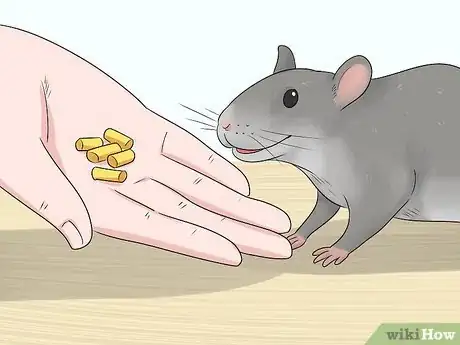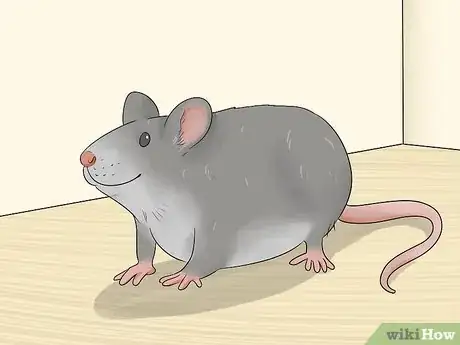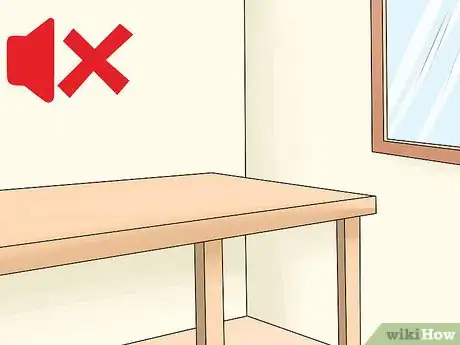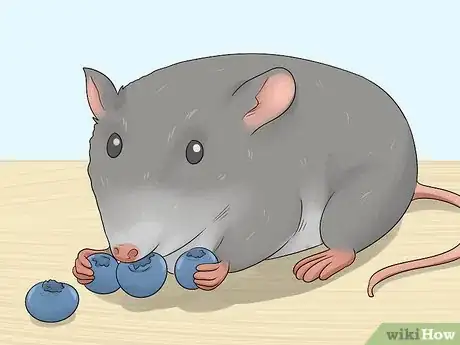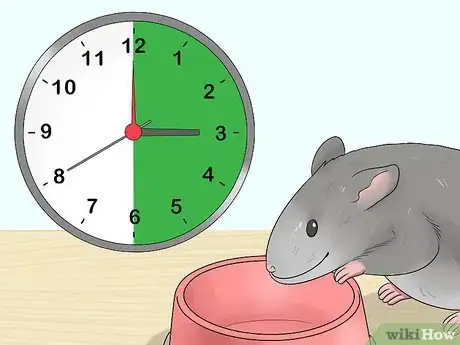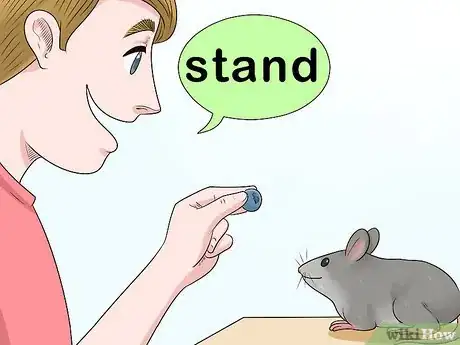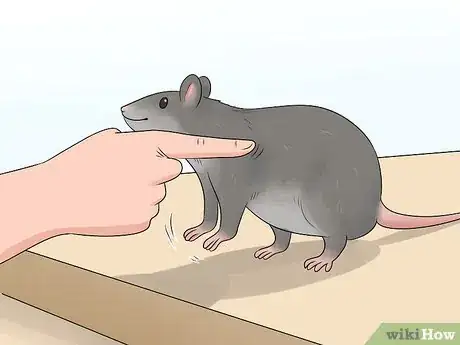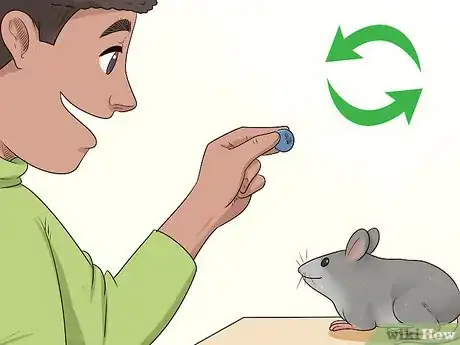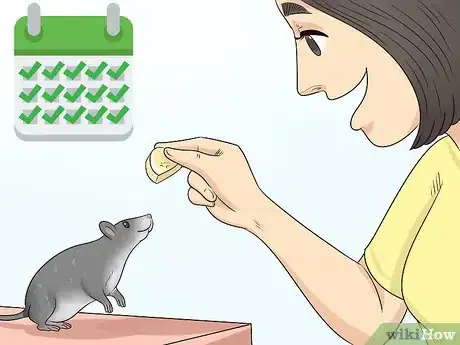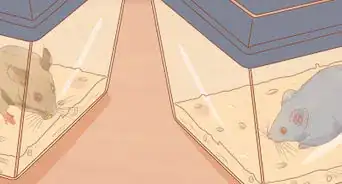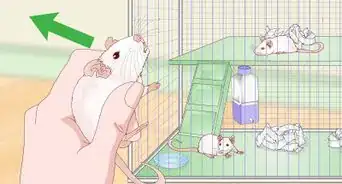This article was co-authored by Brian Starr. Brian Starr is a Rat Specialist and Breeder and the Owner of OC Dumbos out of Central Florida. As America’s only breeder of pet Roof Rats, Brian and OC Dumbos specialize in rat breeding, training, and care. Years of experience and several generations of careful breeding have allowed Brian and OC Dumbos to create a line of tame Roof Rats, bred to make friendly, fun pets. In addition to offering rat accessories and training resources, OC Dumbos also offers free Roof Rat adoptions.
There are 9 references cited in this article, which can be found at the bottom of the page.
This article has been viewed 4,369 times.
Teaching your rat tricks allows you to bond with your pet, and also helps your rat stay mentally stimulated. If you want to teach your rat how to stand on its hind legs, it’s best to start as early as possible, as rats that are under two years of age are more likely to adapt new behaviors. In order to achieve your desired results, you’ll need to condition your rat to respond to food appropriately.
Steps
Creating a Comfortable Training Environment
-
1Tame your rat before you begin the training process. This helps your rat feel comfortable with you and their environment. Many of the tactics involved in rat taming are centered around building trust and security with your rat. Here are a few taming tips:
- Keep rats in a medium-traffic area of the house, so they can enjoy their comfortability without feeling isolated.
- Have conversations in the same room as your rat, so it can become familiar with the sound of your voice.
- Start gaining trust by offering rat treats from your hands, rather than your fingers.[1]
-
2Place your rate on a flat surface. This is where you will teach your rat to stand on its hind legs. There should be few to no other objects on the surface. Otherwise, your rat might be distracted. Flat surfaces also make it easy for rats to balance themselves properly.
- Be sure to train on hard surfaces; even soft ground can be a tricky problem for the rat.
- If possible, train your rat near their cage. This enhances comfortability.
- If you have a shy rat, expose them to different floors and flat surfaces to help desensitize them.[2]
Advertisement -
3Choose a quiet environment. Rats are particularly affected by sound. In fact, rats can hear ultrasonic sounds that humans cannot.[3] Because they can hear ultrasonic frequencies, little sound bits, like a wire cage moving, fingers snapping, or the crumbling of paper, may affect their ability to pay attention.
- If you have other pets, keep them in a separate place while you train your rat.
- It's best to train them when no one else is present. This prevents distraction from noises from other rooms.
- Don't train if you have a cold, fever, flu, or any other sickness that could alter your voice and cause you to cough, sniffle, or sneeze.
Choosing Treats
-
1Choose the right treat for your rat. Because rats are so motivated by food, you’ll be using tiny, bite-sized treats to wean them into their new trick.[4] There are many different types of food your rat will enjoy. Use trial and error to determine which food your rat is particularly fond of. Here are some examples of food your rat might prefer:[5]
-
2Take note of which treat your rat likes the most. This is the treat you’ll use during training sessions. If your rat enjoys a particular food, it will consume the treat eagerly, and sniff around for more.
- You might want to keep a written list to remember their preferential order of snacks. This way, when you want to switch it up later on, you won’t have to repeat this experiment.
-
3Train on an empty stomach. If your rat is full, they’ll be less likely to be motivated by a treat. Rats’ stomachs are completely empty after 6 hours of feeding. Keep this in mind between training sessions so that you can time your treats accordingly. Otherwise, if your rat is too hungry, it may not be able to concentrate on the lesson you’re trying to teach.
Training Your Rat To Stand
-
1Hold the rat treat in your hand, and firmly say, “stand” or “up." Choose a cue that’s comfortable for you. Not only do treats help the rat learn to stand on its hind legs, but also makes you more trustworthy to your pet. Once they understand this reward system, they will be more receptive to learning new behaviors. Raise the treat above the rat’s head, and allow the rat to investigate it.
- Use a clicker to train the rat if they are particularly nervous. A clicker makes it easier for the rat to associate positive interactions with a simple noise.[8]
- Refrain from shouting at the rat because, as may become scared or uncomfortable with loud shouting. Think about how you would discipline a child: instead of screaming, you’d speak with an authoritative voice. This is the same voice you want to use while training your rat.
-
2Praise your rat when it attempts to stand to inspect the item. This helps the rat understand that it is behaving correctly. During these early stages, it’s important to acknowledge their efforts. Early acknowledgement eases them into learning a trick completely.
- To praise them, say the pet’s name softly, and gently rub their hair with your fingertips, letting them know they’ve done a good job.
- Rats particularly enjoy being rubbed on their heads, necks, and up to the middle of their backs. If you get too close to the tail, it will be too sensitive and uncomfortable.[9]
- After you’ve praised them, allow them to have the treat.
-
3Repeat the process, adding a little more height each time.[10] As you hold the treat for your rat, raise your hand a little higher, encouraging them to stand taller to reach the treat. Again, be sure to firmly say your preferred cue while doing this. Once they have successfully investigated the treat at the height of your hand, raise it a few centimeters at the time.
- If you raise the treat too high at once, they may become discouraged; it should never be higher than the length of your rat’s outstretched body.
-
4Practice each day. Rats understand repetition, and can learn better through repeated attempts with positive reinforcement.[11] If you notice that your rat is becoming complacent with their treats, switch it up and choose another treat they like. Refer to your list of preferred treats to give them something new to look forward to.
- Practice five times per day in 10-minute sessions for optimal results.[12]
-
5Say your cue word without a treat. Eventually, your rat will associate the word “stand” or “up” with getting on its hind legs and receiving a treat.[13] Practice saying your cue word to encourage the rat to stand without receiving food. This should be achievable within just a few days. Reward your rat once it has stood on its hind legs on command.
- If your rat continues to have trouble standing on command without a treat, repeat the steps.
Warnings
- Don't teach your rat multiple tricks at once, even if they seem related (for example, sitting and standing). To prevent confusion, teach them one trick at a time.⧼thumbs_response⧽
- Don't offer your rat treats with dirty hands. They may mistake the smell on your fingers for food, and bit you. Alternatively, they may associate the treat with a bad smell.⧼thumbs_response⧽
References
- ↑ https://pethelpful.com/rodents/Bonding-with-your-Rats-A-Beginners-Guide
- ↑ https://www.nytimes.com/2016/07/31/magazine/how-to-train-a-rat.html
- ↑ http://www.ratbehavior.org/rathearing.htm
- ↑ https://www.petmd.com/exotic/training/how-train-your-rat-simple-commands-and-tricks
- ↑ https://www.petmd.com/exotic/training/how-train-your-rat-simple-commands-and-tricks
- ↑ Brian Starr. Rat Specialist & Breeder. Expert Interview. 27 April 2021.
- ↑ Brian Starr. Rat Specialist & Breeder. Expert Interview. 27 April 2021.
- ↑ https://www.joinrats.com/ModifyBehavior/ClickerTrainingRats/
- ↑ https://healthypets.mercola.com/sites/healthypets/archive/2011/04/07/surprising-facts-about-pet-rats.aspx
- ↑ https://www.petmd.com/exotic/training/how-train-your-rat-simple-commands-and-tricks
- ↑ https://www.tandfonline.com/doi/abs/10.1080/14640746608400017?journalCode=pqje19
- ↑ https://www.nytimes.com/2016/07/31/magazine/how-to-train-a-rat.html
- ↑ https://www.petmd.com/exotic/training/how-train-your-rat-simple-commands-and-tricks
- ↑ https://www.pets4homes.co.uk/pet-advice/how-to-teach-your-rat-tricks.html
